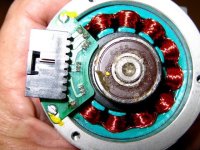I sure hope you are right Fechter.... I wish I had paid more attention in my Electromagnetism classes.....
I am really intimidated by placement. My self doubt soars... "Should I move it 1mm to the left

? 2mm to the right

???"
I called Bob to try to suggest the idea of gluing in the halls.
Got his helper - never got a call back.
I have no doubt that the technical solution to this problem is trivial in the right hands
The problem we really have is a human resources issue / personality issue.
If Bob decides to help us - we will be done - just like that (who is better too... He designed the motor)
If another member decides to solve the problem - we will also be done.
I will pay for the cost of building the first external hall board if someone will grease the skids and get Bob moving.
My only requirement is that the board work for both 3210 and 3220 motors so we can sell enough to offset some of the prototype cost.
If there is a member confident enough to glue in sensors and say for sure they are placed correctly I will drop-ship you a 3210/3220 and pay for the parts and time.
(and buy you an ice cream cone

Any flavor you want)
Can someone point me to the reading material I need to go through to systematically place sensors?
I dont even know where to start. . .
I have all the right tools - scopes, meters, etc. Just need the know-how.
-methods









